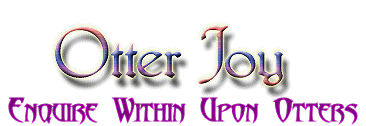Social Behaviour of the Giant Otter
The Group, or Holt
Giant Otters are very social animals, and live in groups of about 5 to 10 members, sometimes called a 'holt'. This consists of a permanently bonded alpha pair and one or two litters of offspring. There are roughly equal numbers of males and females in each group. The alpha female, who regulates hunting, resting and sleeping periods, leads the holt but apart from this, there is no apparent hierarchy. Both sexes defend the group, but it is generally the males' responsibility to warn off intruders or transients. Direct conflict is thought to be rare, however.Transients, or "solitarios", are usually young otters, two or three years of age, who set off to find unrelated mates and new territories to found their own groups. They may also be alphas that have lost their mates. Transients only join an existing group if they replace a dead alpha. Some transient young return to their family after a while if their search is unsuccessful, which given the increasing fragmentation of the population is probably becoming more common.
Recently, there has been evidence of a transient male killing and eating a young giant otter. This has not been seen in the wild before. The reason is unknown.
Existing groups do not exchange members, but may temporarily coalesce around very abundant food, or when travelling in search of new territory (often as a result of disturbance by Man).
The group hunt, groom, rest and sleep together -they like to be in physical contact with each other. Even when hunting, they are seldom out of sight and never out of calling distance. The group shares babysitting duties, and rally together to drive off major predators such as mature black caiman (Melanosucus niger).
Grooming
Grooming is very important both for coat maintenance and for social bonding.When an otter leaves the water, it will rub and roll energetically to dry the guard hairs and squeeze water from the underfur. Sometimes it will scratch at the substrate first, and ends up with soil caked on its fur. Then it will scratch with its hind leg, digits (and claws) curled downward, and nibble its fur with its incisors, lips and tongue. The forepaws, digits fanned, are used to rub down the fur, especially on the head, around the eyes, muzzle and ears. Single digits are used to remove food lodged between the teeth.
Giant Otters often groom one another, and mated pairs do this a great deal. When they finish, they will often lay side-by-side, one with a paw over the other, or nose-to-tail with their heads resting on each other's back.
Territory
Giant Otters maintain a large territory or home range, which varies in size according to the season, but is generally 12-32km of creek or 20 sq. km of lake. Of this, there is a small exclusive core of 2-10km of bank or 5sq. km of lake which is defended against other otters in the dry season, though it is abandoned in the rainy season; this is where the main campsite and breeding den is situated.The larger territory can overlap with that of other groups, although there are now few places with a high enough population density to necessitate this. Territories are patrolled and marked with spraint, anal gland secretion and campsites. They can also be expanded. Direct conflict with other groups is avoided, however - the spraint and so on is used to warn off others, thus avoiding fighting.
| Giant Otter |

